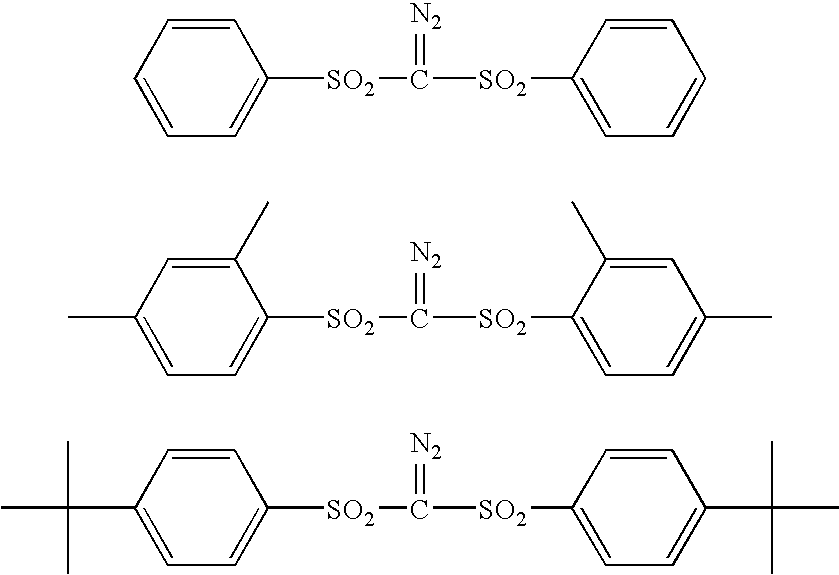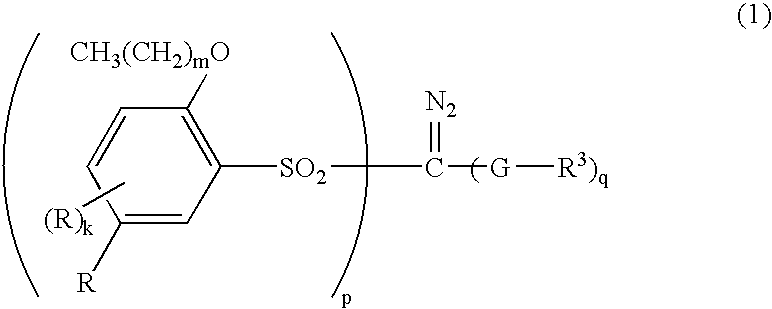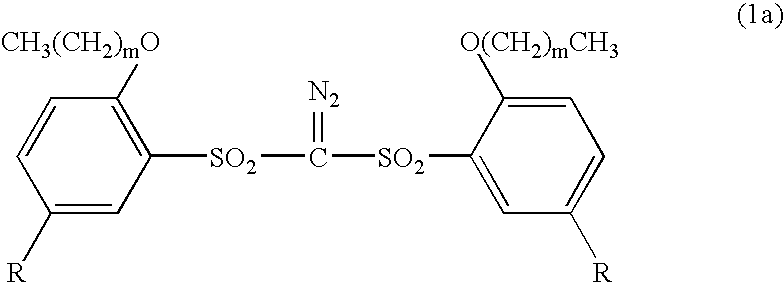Sulfonyldiazomethanes, photoacid generators, resist compositions, and patterning process
a technology of photoacid generator and diazomethane, which is applied in the direction of photosensitive materials, instruments, photomechanical equipment, etc., can solve the problems of resist film removal, poor affinity to or solubility of developers, and unsolved problems of insoluble matter upon development and/or resist film removal, etc., and achieves a well-defined pattern profile and satisfactory heat resistance
- Summary
- Abstract
- Description
- Claims
- Application Information
AI Technical Summary
Benefits of technology
Problems solved by technology
Method used
Image
Examples
synthesis example 1
Synthesis of 2-(n-hexyloxy)-5-tert-butylthiophenol
[0467]In 158 g of ethanol were dissolved 105 g (0.7 mol) of 4-tert-butylphenol and 30.8 g (0.77 mol) of sodium hydroxide. To the solution at 70° C., 127 g (0.77 mol) of n-bromohexane was added dropwise. The solution was allowed to ripen for 4 hours and cooled to room temperature, after which 158 g of water was added. The oily phase was separated therefrom and concentrated on a rotary evaporator, yielding 167 g of an oily matter. Then 167 g of the oily matter was dissolved in 600 g of dichloromethane. While cooling in an ice / water bath, 100 g (0.625 mol) of bromine was added dropwise at a temperature below 10° C. After the completion of dropwise addition, 300 g of water was added. The organic layer was separated and washed with a saturated sodium hydrogen carbonate aqueous solution. The organic layer was concentrated on a rotary evaporator, yielding 208 g of an oily matter. On analysis by gas chromatography / mass analysis and gas chrom...
synthesis example 2
Synthesis of bis(2-(n-hexyloxy)-5-tert-butylbenzenesulfonyl)methane
[0469]In 230 g of ethanol were dissolved 115 g (0.39 mol) of the above 2-(n-hexyloxy)-5-tert-butylthiophenol and 16.4 g (0.41 mol) of sodium hydroxide. Then 23.1 g (0.27 mol) of dichloromethane was added dropwise at a temperature below 50° C. The solution was heated on an oil bath to 60° C. and allowed to ripen at the temperature for 3 hours. The solution was allowed to cool down to room temperature, after which 420 g of water and 300 g of dichloromethane were added. The organic layer was separated and the solvent was removed by means of a rotary evaporator, yielding 124 g of formaldehyde bis(2-(n-hexyloxy)-5-tert-butylbenzenethio)acetal.
[0470]To 400 g of acetonitrile were added 124 g of the formaldehyde bis(2-(n-hexyloxy)-5-tert-butylbenzenethio)acetal and 1.9 g (0.0058 mol) of sodium tungstate. The solution was heated on an oil bath to 70° C. Then 94 g (0.97 mol) of 35% aqueous hydrogen peroxide was added dropwise ...
synthesis example 3
Synthesis of bis(2-(n-hexyloxy)-5-tert-butylbenzenesulfonyl)diazomethane
[0471]In 120 g of dichloromethane were dissolved 12.1 g (0.02 mol) of the above bis(2-(n-hexyloxy)-5-tert-butylbenzenesulfonyl)methane and 5.9 g (0.03 mol) of p-toluenesulfonylazide. The solution was cooled on an ice bath, and 3.0 g (0.02 mol) of 1,8-diazabicyclo[5.4.0]-7-undecene (DBU) was added at a temperature below 5° C. The solution was allowed to ripen at room temperature for 2 hour, after which 100 g of water was added. The organic layer was separated and washed with 100 g of water, after which the solvent was removed by means of a rotary evaporator, obtaining 35 g of an oily matter. It was purified by silica gel column chromatography (eluent: dichloromethane), obtaining 4.5 g (yield 35%) of the end compound, bis(2-(n-hexyloxy)-5-tert-butylbenzenesulfonyl)diazomethane.
[0472]The thus obtained bis(2-(n-hexyloxy)-5-tert-butylbenzenesulfonyl)diazomethane was analyzed by nuclear magnetic resonance (NMR) spectr...
PUM
| Property | Measurement | Unit |
|---|---|---|
| temperature | aaaaa | aaaaa |
| time | aaaaa | aaaaa |
| time | aaaaa | aaaaa |
Abstract
Description
Claims
Application Information
 Login to View More
Login to View More - R&D
- Intellectual Property
- Life Sciences
- Materials
- Tech Scout
- Unparalleled Data Quality
- Higher Quality Content
- 60% Fewer Hallucinations
Browse by: Latest US Patents, China's latest patents, Technical Efficacy Thesaurus, Application Domain, Technology Topic, Popular Technical Reports.
© 2025 PatSnap. All rights reserved.Legal|Privacy policy|Modern Slavery Act Transparency Statement|Sitemap|About US| Contact US: help@patsnap.com



